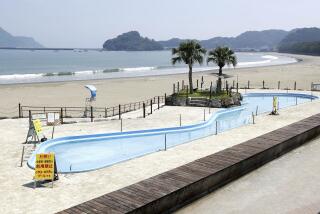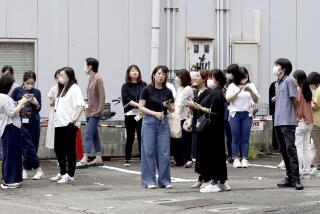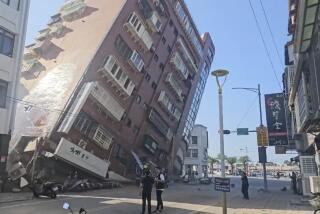6.2 Quake, Strongest in 56 Years, Jolts Tokyo; No Major Injuries
TOKYO — The strongest earthquake to hit Tokyo in 56 years--a jolt that registered 6.2 on the Richter scale--shook the Japanese capital Friday night but caused no damage or major injuries.
As precautionary measures, the high-speed “bullet trains” on all three lines running into Tokyo from Osaka, Niigata, and Morioka were shut down for up to 20 minutes to check for track damage. Both Tokyo airports, Haneda and Narita, were closed briefly, and three subway lines halted operations for several minutes.
The worst trouble was caused by a rush of telephone calls, apparently by people checking on relatives and friends, which jammed circuits in some sections.
16 Slightly Hurt
Sixteen people suffered minor injuries of the type that normally go unreported. One 7-year-old girl, for example, was hurt when a camera fell on her, and a 79-year-old woman was shaken from her bed and broke her wrist.
A newscaster for the NHK television network, who was interrupted during a 9 p.m. newscast, said elevators at NHK’s headquarters had stopped and that a large lighting fixture above him shook violently but did not fall.
A guest at the Imperial Hotel said people were advised not to go outside.
The earthquake, at 9:26 p.m. with its epicenter 25 miles north of Tokyo, seemed to cause vertical jolts that ended quickly. It registered 5--what Japan’s Central Meteorological Agency describes as “a strong earthquake”--on the Japanese earthquake scale, which runs to 7, and was felt from Akita in northern Honshu to Tottori in the southwestern section of Japan’s main island.
It came 15 hours after an earthquake registering 2 on the Japanese scale--classified as “a weak tremor”--passed almost unnoticed in Tokyo. The morning tremor registered 5.6 on the Richter scale and was centered beneath the Pacific Ocean near the Boso Peninsula, southeast of Tokyo, the Meteorological Agency said.
The morning tremor was given only minimal notice in evening newspapers, but the evening jolt caused NHK to extend its normal 40-minute news analysis show by 20 minutes.
The Meteorological Agency quickly announced that there was no danger of tsunami (seismic sea waves).
Accustomed to Quakes
Tokyo’s 11.4 million residents, accustomed to frequent earthquakes, often do not even stop their conversations during minor tremors. But the evening jolt halted normal activity, as people watched bookcases sway and rushed to turn off gas ranges. Diners in the 46th-floor restaurant of the Keio Plaza Hotel were reported disturbed, but not panicked, by the jolt which came 15 days after the first of two major quakes hit Mexico City.
Evening newscasts had carried film of Foreign Minister Shintaro Abe inspecting earthquake damage in Mexico City, where he made a special visit on the way home from a trip to Brazil to offer $50 million in Japanese aid.
The last earthquake to register 6.2 on the Richter scale hit Tokyo on July 27, 1929. That quake also caused no serious damage or injuries.
Many Tokyo residents have become more nervous about earthquakes in recent years. Some Japanese seismologists say major quakes strike the Tokyo region in cycles of about 60 years, and 62 years have now passed since the great Kanto earthquake of Sept. 1, 1923, which killed 140,000 people.
More to Read
Sign up for Essential California
The most important California stories and recommendations in your inbox every morning.
You may occasionally receive promotional content from the Los Angeles Times.










